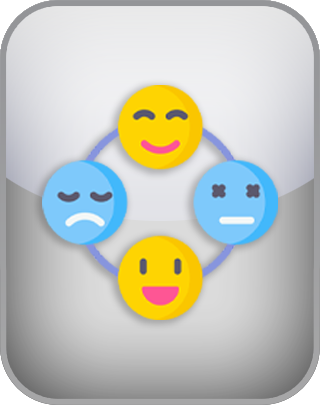Emotional Granularity Test
This Emotional Granularity Test, inspired by the work of university researchers, measures how precisely individuals identify and differentiate their emotions. Unlike general mood assessments, this test evaluates one’s ability to label emotions with specificity—such as distinguishing between “irritated” and “frustrated” rather than just “angry” Higher emotional granularity is linked to better emotional regulation and mental health. Research highlights that finely tuned emotional awareness supports effective coping and interpersonal communication.
What is your emotional granularity like? To take the test, enter your input below.
Question 1 of 20
I can tell the difference between feeling anxious and feeling excited.
| Disagree | Agree |
NEXT
The Emotional Granularity Test is inspired by the concept of “emotional granularity,” a term explored in research at university studies pertaining to the field of affective science. Emotional granularity refers to the degree of precision with which people can identify and distinguish between different emotions. Instead of grouping feelings into broad categories like “happy” or “sad,” a person with high emotional granularity can articulate more subtle distinctions, such as separating “irritated” from “angry” or “disappointed” from “melancholy.”
The scientific work, along with research from online studies, suggests that emotional granularity plays a critical role in emotional intelligence and overall well-being. Individuals who can label emotions more precisely tend to regulate them more effectively, respond more appropriately to challenges, and communicate their inner states with greater clarity. This, in turn, supports healthier interpersonal relationships and greater resilience in the face of stress.
The test presented here is not a clinical tool and is not connected to any specific research instrument created specific researchers in the field. Instead, it is an independent and informal exercise inspired by the scientific concept. It invites participants to reflect on how specifically they can identify their emotional states. By doing so, it encourages greater awareness of one’s emotional vocabulary and its potential impact on behavior and decision-making.
In practice, emotional granularity is often explored in research through linguistic analysis, self-report measures, or real-time emotion tracking. In this informal adaptation, you will encounter prompts that ask you to identify or differentiate emotions in a variety of contexts. Your responses can offer a snapshot of how nuanced your emotional perception might be. While it won’t yield a clinical score, it can spark valuable self-reflection.
Why does this matter? Studies have found that people with high emotional granularity are better able to tailor their coping strategies to specific situations. For example, someone who can identify feeling “tense” rather than simply “bad” might choose a calming activity over venting anger—an approach more likely to address the root of their discomfort. Similarly, distinguishing “lonely” from “bored” can guide you toward social connection instead of aimless distraction.
The implications extend beyond personal growth. In educational contexts, teaching students to develop a richer emotional vocabulary can improve emotional literacy and peer relationships. In workplace settings, leaders and teams who communicate emotions more precisely can reduce misunderstandings, manage conflicts more effectively, and create a more emotionally intelligent culture.
Ultimately, the Emotional Granularity Test is a tool for exploration, not diagnosis. It draws inspiration from well-established psychological theory to help you better understand your inner landscape. By engaging with the questions, you may become more attuned to the subtleties of your feelings—and in turn, more equipped to navigate them constructively. While the idea is grounded in academic research, the experience here is meant to be approachable, engaging, and thought-provoking for anyone curious about the complexity of human emotion.
References
- Harvey, K. J., & Espie, C. A. (2004). Development and preliminary validation of the Glasgow Content of Thoughts Inventory (GCTI): A new measure for the assessment of pre-sleep cognitive activity. British Journal of Clinical Psychology, 43(4), 409–420.
- Watts, F. N., Coyle, K., & East, M. P. (1994). The contribution of worry to insomnia. British Journal of Clinical Psychology, 33(2), 211–220.
- Wicklow, A., & Espie, C. A. (2000). Intrusive thoughts and their relationship to actigraphic measurement of sleep: Towards a cognitive model of insomnia. Behaviour Research and Therapy, 38(7), 679–693.

